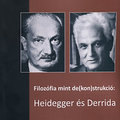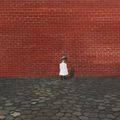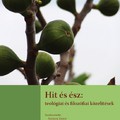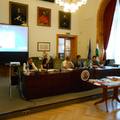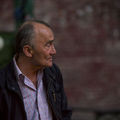Ez alkalommal ket nyelven irom rovid kepeslap-szovegem, hogy alkalmi idegenvezetom is elolvashassa azt.
A Krakkoi Nemzeti Muzeumben jartunk, ahol Turner kiallitas lathato 2012 januarjaig. A koncepcio a hamburgi Bucerius Kunst Forumtol szarmazik.
Elter tehat a nemreg Magzarorszagon jart anyagtol. Itt nem az antikizalo tajkeptol valo elszakadas all a kozeppontban, hanem a bemutatott 84 kep (joreszt a Tate anyaga) azt hivatott abrazolni, hogy jelenik meg e romantikus muvesz alkotasaiban az antik hagyomany ota ismert negy elem (tuz, viz, levego, fold), s hogy valtozik mindez a korabeli tudomany hatasara valami massa - s vegul hogy elegyedik a negy elem Turner erett muveszeteben. A koncepcio jol hangzik, am az anyag meglehetosen sovanykara sikeredett. Fokent akvarell kepek hivatottak igazolni az elmeletet. S bizony az igazolas nem mindig sikeredik meggyozore. Igy marad a szokasos Turner-csodalatunk - hogyan szakad el a figuralis abrazolastol a vihar, a feny es a viz jatekanak abrazolasa soran a festo.
A kiallitas erdeme viszont egy sotet terem, ahol hangok jelenitik meg az elemeket, nezoi kepzeletunkre bizva a tobbit.
S az eloterben is erdekes vegignezni, ahogy egz kepernyon Simon Schama probalja eligazitania tanacstalanabb nezoket a muveszet rejtelmeiben.
This time I write in two languages my postcard message, in order to let my unprofessional guide as well to read it.
We have seen a temporary exhibition in the National Museum in Krakow, presenting Tuner and the Elements, until early January, next year. The conception of it was created by Bucerius Art Forum, Hamburg.The exhibition differs therefore from the one presented a bit earlier in Budapest. Here the focus is not on the change from classical landscape into something modern, but the presented 84 paintings are meant to illustrate how the four elements of the antique tradition (fire, water, air and earth) are represented in the works of art of this Romantic painter, and how this changes into something else as a result of the influence of early 19th century science - and finally, how the four elements fuse in the mature art of Turner.
This conception sounds great, but the actual material turns out to be rather weak. Mainly watercolours should prove the thesis. And that is not always convincing. And then we are left with the traditional view of Turner"s talent - how he gets rid of figurative painting, in order to express the vibration of storm, light and water. One obvious advantage of the exhibition is a long, dark room, where sounds present the elements, and our imagination can work to fill out the visual vacuum.
And it is also worthwhile to see on the screen in the lobby how Simon Schama tries to show our way across the mysteries of this artist"s work.
HHF

